Side Menu:
20 Key Reasons Why a Switch Didn't Happen
There are some very basic key reasons why switching Titanic for Olympic not only did not happen, but could not happen, Below is an index to the main points:
1. Titanic was under-insured by $2.5 million
2. Olympic's damage from HMS Hawke did not exceed $125,000
3. Loss of image would have been more costly
4. The sister ships had too many structural and aesthetic differences
5. At least several thousand Belfast workers would have to be silenced
6. The captain, deck officers and crew would all have to be silenced
7. Titanic's passengers would have noticed
8. First class suites on B deck
9. Bruce Ismay and Thomas Andrews were aboard
10. Deliberately sinking a ship highly improbable
11. Photographic record of Olympic post-collision
12. Nobody noticed anything about Olympic after the sinking
13. BOT survey reports and surveys
14. The Olympic wreckers would also need to be silenced
15. What remains of Olympic has Olympic's number 400
16. Ballard and all subsequent explorers would have to be silenced
17. The wreck looks like Titanic
18. The wreck has Titanic's number 401
19. The wreck has the name Titanic on it
20. No evidence Titanic was 'switched' with Olympic
1. Titanic was under-insured by $2.5 million
Quite simply, the fact that Titanic was under-insured and not only that, the remainder 'self-insured', should silence the 'switch' theory from the outset. Essentially Titanic was under-insured by $2.5 million, the reason being that the White Star Line insured it's own ships. On the matter of how much the Titanic cost and how much she was insured for, Bruce Ismay testified at the United States Senate Inquiry on Day 11, Tuesday, April 30, 1912, the following:
Senator SMITH: There has been considerable confusion about the cost of the Titanic. I will take the liberty of asking you to state it.
Mr. ISMAY: She cost $7,500,000 sir.
SMITH: And for how much was she insured?
ISMAY: For $5,000,000, I understand, sir.
This was also clarified by Philip Franklin, vice president of the International Mercantile Marine Co., controlling the White Star Line, earlier in the proceedings, on Day 9 Saturday, April 27, 1912:
Mr. FRANKLIN: This ship was insured with outside underwriters for $5,000,000, in round figures. It was, in pounds, about a million pounds. The company carried the remainder, up to about $600,000 - between $500,000 and $600,000. That is, our insurance fund carried the remainder.
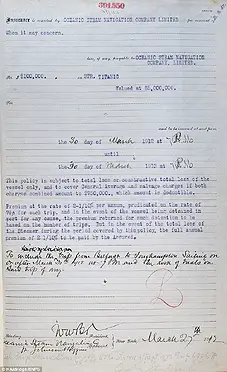
Original insurance certificate covering
the 'total loss' of the Titanic for
$5million. (Click to enlarge)
The United States Senate Inquiry Report established that "the vessel, fully equipped, cost £1,500,000 sterling, or about $7,500,000. At the time of the accident the vessel carried insurance of £1,000,000 sterling or about $5,000,000, the remaining risk being carried by the company's insurance fund." It was entirely normal for a company not to fully insure a ship. Among the White Star Line’s company rules was rule 101, quoted by Franklin at the United States Senate Inquiry during his testimony:
"Commanders are reminded that the steamers are to a great extent uninsured and that their only livelihood, as well as the company's, depends upon immunity from accident. No precaution which insures safe navigation is to be considered excessive."
We have further verification of the figures in The New York Times of April 28, 1912 under the heading of "Titanic Insurance Claims Quickly Met". It states that the "aggregate property loss is placed by The Spectator at $9,420,000, and that insurance authority divides this total into $8,000,000 for the vessel, $420,00 for the cargo and $1,000,000 for personal effects. Marine insurance totaling $6,000,000 on the property is divided into $5,000,000 on the vessel, $400,000 on the cargo, and $600,000 on personal effects." So essentially, the ship was valued at "$8,000,000" while only insured for "$5,000,000".
The fact Titanic was under insured comes from the insurance company itself, Lloyd's. The Lloyd's website has much information on the Titanic case (check here):
"On 9 January, broker Willis Faber & Co had come to Lloyd’s underwriting room to insure the Titanic and her sister ship, the Olympic, on behalf of the White Star Line. It was considered a prestigious risk, with cover for the hull alone standing at £1m – around £95m in today’s money. Numerous Lloyd’s syndicates put their names on the slip, covering amounts ranging from £10,000 to £75,000. Willis was able to negotiate a favourable premium for this proudly ‘unsinkable’ vessel of just £7,500. Despite the high levels of claims arising from the tragedy, insurers paid out in full within 30 days."
So in summary we have independent verification that it cost $7.5 million to build Titanic and that she was insured for only two thirds of that i.e. $5 million. Which means a loss of $2.5 million. Would such a loss be an issue for IMM and the White Star Line? Apparently not. On Thursday, May 9, 1912 during the American inquiry into the sinking, Maurice Farrell (the Managing News Editor of Dow, Jones & Co.) said that the net loss to IMM as a result of the sinking might be "$2,000,000 to $3,000,000," which ‘ought not’ to "break a company like the International Mercantile Marine."

Titanic cost $7.5 million
but was insured for only $5 million.
An article by the Daily Mail, on the 3rd of October 2013 reported that "the original insurance certificate covering the ‘total loss’ of the Titanic for $5 million (£3.1 million) was revealed...showing the cover was taken out two weeks before the ship sank in April 1912. According to the Atlantic Mutual Insurance Company policy, the firm had to pay an excess of $500,000 ($310,000). The policy was arranged through brokers Willis Faber which assembled a consortium of insurers that each took a share of the risk." (Source)
Essentially there was no reason for an insurance scam, as Mark Chirnside points out in his dissertation entitled "Olympic & Titanic – An Analysis Of The Robin Gardiner Conspiracy Theory (July 2006):
Why would the White Star Line or IMM deliberately sink a ship that was liable to loose them some $2,500,000, particularly when (even if the damage to Olympic was worse than accepted) the Olympic could be repaired at what would most probably be a lower cost? And, if a loss of $2,500,000 could be withstood by IMM/White Star after their flagship sank, how could the damage to the Olympic ever have been serious enough for them to take the drastic – indeed, criminal – measure of ‘swapping’ the ships in an insurance scam?
2. Olympic's damage from HMS Hawke did not exceed $125,000
A key aspect of Gardiner's switch theory is that Olympic's collision with HMS Hawke on September 20th 1911 was far more serious than publically known prompting White Star to come up with the 'switch' concept as a means to offset the expense of repairing the Olympic. Specifically, Gardiner claims that the collision damaged the Olympic’s center turbine mountings, that over a third of the hull plating require replacement and most critically, her keel was damaged. However, there is no evidence of this.
There is independent verification of the extent of the damage from those other than White Star during the court case to determine responsibility. Firstly Harry Roscoe a consulting naval architect with over 25 years experience of surveying damage to large steamers surveyed the Olympic at Southampton on September 22nd and 23rd 1911, and later in Belfast in dry dock. Under cross examination during the High Court of Justice Olympic vs Hawke in London, November 1911, Roscoe acknowledged the following description by Examination in chief Mr. Laing as correct:
"There is a large triangular hole extending from immediately above the D deck to above 15 feet below that deck...a large penetration in D deck extending inwards about 8 feet...hole below deck pierced by the Hawke’s ram...in position below the larger hole in deck D...broken and indented plating extend over these decks D, E, F, and G...the penetration cease between G, and the orlop deck"
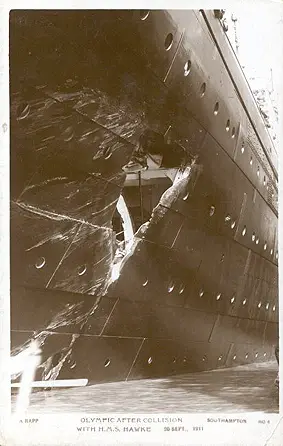
RMS Olympic after the collision
with HMS Hawke.
Roscoe also mentions damage to the starboard propeller bossing and blades and the fact that the the extent of the penetration into the Olympic was between six feet eight inches to eight feet.
Note that Roscoe makes no mention of any damage to the keel, with penetration only 6 to 8 feet. To reach the keel the Hawke would need to to penetrate forty-five feet in, and thirty feet below where Hawke hit the Olympic.
Roscoe's testimony is colloborated by Robert Steele who described himself as a member of the Institute of Naval Architects, member of the Institute of Mechanical Engineers, and a consulting naval architect and engineer for over 20 years. He agreed with Roscoe's damage assessment and interestingly added that the Hawke's "ram has not shown itself to be a very powerful weapon of offence." In other words the damage could have been worse.
Also, Commander William Blunt, who was in charge of the Hawke noted that the "engines reversed before the blow. They were actually going astern at the time of the blow." At the time of the collision he estimated that the speed of the Hawke had reduced from 15¼ knots to "about 8 knots". This considerable reduction in speed is no doubt why the damage was not as severe as it could have been.
According to Titanic researcher Ioannis Georgiou "H&W photographed the damage (the glass plates held by the National Museum of Northern Ireland) and no photograph shows a deep hole under the waterline (to go deep enough into the ship to damage the turbine and keel) as claimed by Gardiner."
In regards to Gardiner's allegation that a third of the hull had to be replaced, in Olympic & Titanic: The Truth Behind The Conspiracy Bruce Beveridge and Steve Hall note that while some of the bow plating was replaced after the Hawke collision they conclude that "there is absolutely no evidence that the forward plating as seen in the Harland & Wolff drawing had resulted from the collision with the Hawke.’
In summary, Mark Chirnside, in his dissertation concludes:
I examine the available evidence surrounding the Olympic’s collision damage – from surveyors’ testimonies, to more recent technical analyses. I argue that there is no reliable evidence to indicate that the damage was worse than admitted and find Gardiner’s research lacking. Every one of Gardiner’s points – such as the failure to use the turbine engine on the journey back to the shipyard, the ‘failure’ of the emergency patch – can be explained with knowledge of contemporary steamships and mechanical engineering without recourse to an astonishing conspiracy theory. There are no credible sources indicating that the damage to Olympic was worse than reported at the time – and indeed ample sworn expert testimony to the contrary."
Ultimately, during the court case of Olympic vs Hawke, in November 1911 it was ‘unofficially estimated that the Olympic’s damage did not exceed $125,000.' The International Mercantile Marine, who owned White Star, wanted to claim for as high as £750,000 by including lost passenger receipts -but only if they won the case (which they didn't). But Chirnisde points that if they stood to loose it would not be an issue:
"The company’s surplus on the profit and loss account had risen from $48,585 in 1910 to $821,062 in the year ending December 31 st 1911. Even if the insurance would not pay out the $750,000, IMM would have remained in surplus. In 1910, IMM’s net profit was a mighty $4,849,580, and this slipped to $4,509,270 in 1911. As for the White Star Line itself, it was ‘the principal constituent’ of IMM and ‘enjoyed continued prosperity, its profit distribution for 1910 being 30 percent’ after depreciation. In fact, White Star’s profit and loss account for the year to December 31 st 1911 was in surplus by £1,102,756 – even higher than IMM’s."
Certainly there is no financial logic to justify an insurance scam.
3. Loss of image would have been more costly
In points 1 and 2 we have established that Titanic under-insured and also that the damage to the Olympic during its collision with the Hawke was not serious enough to justify an insurance scam. But it also must be noted that such an insurance scam would have had far more reaching financial implications. The loss of a ship on its maiden voyage, their newest flag ship no less and touted as 'practically unsinkable' would be a publicity and marketing disaster. This would obviously cause travellers to lose confidence in White Star, a company that was aiming for first class opulence over speed.
As already acknowledged, White Star was doing well enough financially to deem such a scam unnecessary, so taking such a risk with tarnishing its reputation would have been unthinkable and illogical.
This particular point should not be under-estimated -many Titanic authors and researchers believe it is sufficient in it's own right to dismiss the 'switch' as implausible. Titanic author Senan Molony writes that "one doesn’t need to compare designs and count portholes - a moment’s serious consideration of the reputational risk involved - individually and collectively - is all that is required to end any entertainment of the notion. For illustration - apply the idea to another Malaysia Airlines aircraft that has maybe one dodgy engine, being entirely uninsured. How could there be any overall benefit in substituting it for a fully-insured plane and then losing it in an accident?"
4. The sister ships had too many structural and aesthetic differences
Proponents of the 'switch' theory often make the error of assuming that since Olympic and Titanic were sisters ships, making a 'switch' would only have been a matter of changing wherever the name Olympic appeared to Titanic. The reality is that while they were indeed sister ships and at first glance seemingly identical, in fact there were numerous differences, many structural, that meant any switch would have been a huge, extensive, time consuming and not to mention very expensive undertaking. Here is a list of the key differences:
1. Forward half of the 1st class A-deck promenade on Titanic was enclosed with retractable glass screens; the Olympic's promenade was open all the way along.
2. The front of the wheelhouse in Olympic's bridge was curved, but on Titanic its flat.
3. The bridge wings (forward) and the aft docking bridge (stern) on Titanic extended over the ship's side by a couple of feet. On the Olympic, they were flush with the ship's side (prior to 1912/13 refit).
4. The 2nd class promenade area on the Olympic ran for the last quarter of "B deck", but on the Titanic it was truncated to extend the 1st class restaurant out to the port side, and on the starboard side, the cafe parisien was included.
5. B deck was also drastically different on both ships - Olympic had a first class promenade whereas Titanic had two private verandahs and suites that were plush with the sides of the superstructure.
6. The reworked accommodations on B and C Decks, dramatically altered the number and arrangement of the windows and portholes on both decks.
7. Titanic had an extended enclosure aft on C Deck.
8. Titanic had a different arrangement of ventilators, fans, piping and machinery on the Boat Deck.
9. Titanic had carpetting and floor tiles that were different in colour.
10. Titanic had Turkish Bath area on the starboard side of F deck that was different in layout.
11. Titanic's officers quarters were different, with the officers Deck House pushed out more on Titanic than Olympic.
12. On Olympic, the wireless cabin had an outside window, but this was changed on Titanic to allow more seaward facing cabins to be included.
13. On Olympic,the wireless room was on the port side of the officers deck house While on Titanic it was situated amidships.
14. The porthole on the D deck gangway doors was round on the Olympic; on the Titanic it consisted of two vertical rectangular windows.
15. The propellers on the two ships had different pitches and were therefore not interchangeable.
16. The reception room on Saloon Deck "D" was larger on Titanic than Olympic; Titanic had more columns than Olympic.
17. Titanic was 4 inches longer than Olympic.
18. Olympic's bridge roof was painted white while Titanic's was bare planking (or possibly painted gray).
19. The top of Olympic's breakwater was painted brown while Titanic's was white.
20. Olympic's outdoor forward stairs had covers while Titanic's did not
21. The porthole arrangements on Shelter Deck "C" between the two ships were different.
22. The lounge furniture on both ships had their ships own names on them.
23. Modifications would result in Titanic having 1,004 gross tons(or 100,400 cubic feet) more enclosed space than the Olympic.
24. The paintings in Titanic's smoke room was "Approach to Plymouth Harbour" while on Olympic Was "Approach to the New World."
25. Titanic had additional cabins on the Promenade Deck "A" around the aft staircase.
26. Olympic had open third class berths, Titanic did not
27. Another reception room was added to Titanic's Bridge Deck "B" next to the A la Ca rte restaurant.
28. Different air vent arrangement around the funnels
29. The steel plating arrangement on the two ships was noticeably different, especially around the bow plating around the anchor; two plate-edges were welded together on Titanic, but left unwelded on the Olympic.
30. The iron gates of the three elevators were different on Titanic wreck than photos which show them on Olympic.)
This list does not include the shell-plating at the bow and stern which bore the ships’ names. The names weren’t just painted on the plates, they were cut into the plates in letters four feet high and one-half inch deep.
In Mark Chirnside summarises the situation:
Olympic and Titanic were very similar. Essentially, they shared the same hull size and design and were constructed from the same set of plans; however, particularly after Olympic’s maiden voyage, Titanic was improved in a number of ways. By the time she entered service, Titanic’s forward promenade deck had been glass-enclosed; on B-deck, her first class á la Carte restaurant had been expanded and a Café added, while all the first class suites were expanded and improved, with two ‘parlour’ suites even getting their own private promenades. These were major structural changes. There were a great deal of subtle differences, too many to list here, from different colour schemes for public rooms, different décor in some first class cabins, to deckhouses and vents...As far as I can see, Gardiner’s theory makes no attempt to address even well-known differences – such as the bridge and officer’s deckhouse on the boat deck, for instance, and merely assumes (incorrectly) that the two ships were much more similar than was the case.
Another often overlooked aspect of this theory is that it would not only involve making changes to Olympic to look like Titanic, but also making all the same changes to make Titanic look like Olympic. For example, Olympic's port and starboard navigational wing cabs (on either side of the bridge) did not protrude from the ship as they did on Titanic, so these would have to be extended several feet. Conversely, on Titanic the wing cabs would have to be moved inwards to match Olympic's look. Even more incredible is that after the Titanic disaster the bridge wings were in fact extended during the 1912/13 refit -which means to believe the 'switch' would mean believing that the wing cabs were moved twice -first inwards (to look like Olympic) and then a year extended outward again! In other words there would be a huge amount of work involved on both ships to make the 'switch' look convincing - all of which would have to be done in total secrecy.
And finally, there's the ships' inventories, which would have included the manufacture numbers on such items as the engines and turbines, all of which would again require some major work to switch so as to match their respective 'switch' identity.
For more information on the myriad of differences between the two ships and the huge amount of work to switch them please read Steve Hall and Bruce Beveridge's book Titanic or Olympic, Which Ship Sank?
5. At least several thousand Belfast workers would have to be silenced
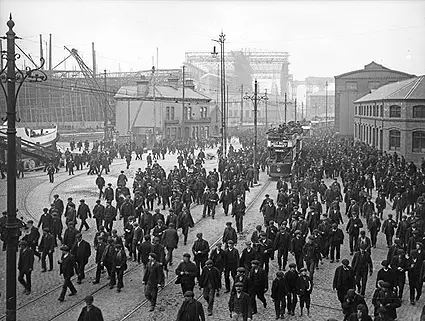
Just some of Harland & Wolff's 15,000 employees
who would have to be kept "quiet" about the switch.
Common estimates for the number working at Harland and Wolff during the construction of the Olympic Class ships is 15,000. Since Titanic was behind schedule due to issues with Olympic, and both ships would have been in the yard at the same time, for a switch to have occured there must have been at the very least (looking at the list of changes required listed above) several thousand employees involved. If not all 15,000 were involved in the switch, how was it concealed from the rest and with what motive? As one Belfast man once said: “How on earth can anyone expect 15,000 Irishmen to keep a secret?”
6. The captain, deck officers and crew would all have to be silenced
Far more than just Harland and Wolff employees would need to be silenced. The Captain and many of the officers and crew came straight from Olympic to Titanic. Having spent almost a year working on Olympic they would inevitably discover very early on that they were still on the same ship. To illustrate hypothetically, the very same scuff marks on the door to their officer's quarters would be enough of a clue, let alone the numerous structural alternations. Notoriously superstitious, there would have been instant suspicion, leading to widespread gossip, discussion and ultimately a demand for an explanation.
Mark Chirnside also points this out:
In practical terms, I would go so far as to say that a switch was impossible. Even if the two ships were as similar as Gardiner’s theory indicates, you simply cannot pass off a one-year-old ship for a new one. Too many people would have noticed things such as the inevitable wear and tear, particularly the crew who joined Titanic in 1912 having served on the Olympic beforehand. Stewardess Violet Jessop, who served on both ships, writes in her memoirs about how ‘improved’ Titanic was when compared to Olympic, which amply demonstrates differences that might not sound significant, but were nevertheless noticeable to a ship’s crew.
7. Titanic's passengers would have noticed
Even more unbelievably, Titanic's passengers would also have to be silenced about the 'switch' as they also would have immediately noticed something was awry. This seems to be another aspect lost on those who support the 'switch' theory; that there are many survivor accounts mentioning how 'new' and wonderful Titanic was, of smelling fresh paint and thick carpets. So to our already overweight list of changes to switch Olympic for Titanic we must now also add completely redecorating the ship to appear "as new," re-painting and re-carpeting all her interiors.
Mark Chirnside notes this also:
Olympic proved herself very popular in 1911 and carried over 17,000 passengers, setting a number of records. A number of Titanic’s passengers had sailed on Olympic before and it is hard to believe that they would not have noticed that they were travelling on exactly the same ship.
8. First class suites on B deck
In an apparent effort to mitigate the amount of work involved in recreating the Olympic as Titanic Gardiner claims that "B-deck was an open promenade and partitions were erected to enclose the promenade area and create the illusion that larger suites had been installed." However there is a large error with this hypothesis as Chirmside points out:
Another blow to Gardiner’s theory comes from our knowledge of the passengers who had booked the first class suites on Titanic’s B-deck. These passengers had booked suites which extended to the ship’s side and had a sea view. Two of the enlarged B-deck suites – unique to Titanic – earned the nickname the ‘millionaires’ suites’ based on their expensive price tag, and in a review of Gardiner’s book Michael Tennaro has noted: ‘One of Titanic’s [millionaires’] suites was used by the Cardezas [an American family] during the maiden voyage. Did they just imagine they were living in these sumptuous quarters?’ Gardiner does not address this, and even more inconsistencies become apparent.
9. Bruce Ismay and Thomas Andrews were aboard
Switch adherents often point to the alleged last minute cancellation of IMM owner J.P. Morgan as evidence (more on this here), while neglecting to mention that the two most prominent people behind an alleged 'switch' -and hence with the most to lose and far more reason for absence- would have been the managing director of the White Star Line Bruce Ismay and Harland & Wolff designer Thomas Andrews. Not to mention that Ismay escaped aboard collapsible C. If he was part of an intricately planned pre-arranged sinking, why did he escape so willingly aboard a lifeboat, an act for which he was henceforth severely criticised, while Andrews went down with the ship with no apparent effort at survival?
There is also an unconfirmed account that Ismay forgot to sign the insurance certificate protecting White Star against claims from some of the richest people and their families aboard Titanic. The certificate, still unsigned, went down with the Titanic. If true, this would certainly not make sense if Ismay was playing a part in a complex insurance scam.
10. Deliberately sinking a ship highly improbable
If you follow through Gardiner's 'switch' theory you come across a highly complex pre-arranged sinking scenario which would have required incredible precision (not to mention expense and vast numbers of people to keep quiet). Would White Star, attempting an insurance scam to recoup money lost on Olympic, attempt such a daring and highly complex pre-arranged sinking scenario? Remember the sinking of Titanic came about due to a freak set of circumstances. Ice was further south than normal for that time of the year. It was a moon-less (very dark) and extraordinarily calm night, meaning that an iceberg was spotted much later than normal. The way the ship made contact with the iceberg (brushing its starboard side) breached more watertight compartments than were designed to be breached, leading to water overflowing the bulkheads and an eventual sinking of the vessel. If it was a head on-collision, or fewer watertight compartments were breached, she may not have sunk.
The reality is that if White Star did indeed want to attempt an insurance scam it would be highly unlikely they would try such a phenomenally complex sinking based on such a large number of variables and freak circumstances. It would simply have been much easier to - for arguments sake - start an accidental fire while at sea and the evidence would have disappeared much quicker, with far less people, time or expense to worry about.
The fact is that swapping the two ships and sinking the Olympic, disguised as the Titanic, could hardly be expected to improve the White Star Line’s financial situation (which was not in trouble anyway - see point 1above). In fact, it would almost undoubtedly cause the opposite, as not only would they experience unpredecented bad publicity, but to make matters worse, they would only be left with one of the two sisters for their express service, with the third liner still incomplete, at a time when rivals such as Cunard and Hamburg-Amerika were on course to be operating three-ship services within a very few years, not to mention the cost of building a suitable replacement.
11. Photographic record of Olympic post-collision
'Switch' proponents will often point to alleged inconsistencies in Titanic's photographic record while omitting to note that the photographic record of Olympic (allegedly Titanic) post-disaster has absolutely no evidence of any 'switch'. This should not be underestimated. Compared to Titanic's very short life of a few days in April 1912, the Olympic served for 24 years from 1911 to 1935. Hence, the number of photographs taken of Olympic far exceeds that of Titanic. Surely if there was indeed a 'switch' there would be at least one suspicious photograph during the 24 years? If anything Olympic's photographic record solidly reveals that she was the Olympic.
For example: There was a subtle but unmistakeable difference in the bow plating around the anchor; two plate-edges were welded together on Titanic, but left unwelded on the Olympic. Pre & post disaster photos of Olympic show the unwelded plate-edge around the anchor.
As another case in point take a look at the image below of Olympic's starboard wing cab, taken after the Olympic's collision with the Nantucket in 1934 (taken from footage you can view here). Remember that Titanic's wing cabs protruded significantly from more the body of the ship, unlike Olympic which did not. Here we see a wonderful close up -and no evidence at all of any structural changes being made to reduce the amount the wing cab would have protruded if this was indeed Titanic.
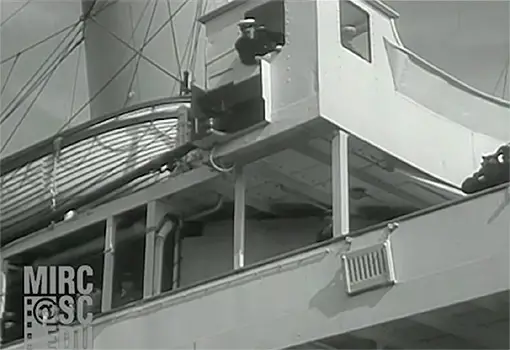
The underside of Olympic's staboard wing cab. There is nothing here to even hint at the large structural alterations required to make a 'switch'.
12. Nobody noticed anything about Olympic after the sinking
The Olympic served until 1935, and yet there is no evidence -even hearsay- from any of the hundreds of thousands of crew and passengers who sailed aboard Olympic post-Titanic disaster.
And it is not as though there were not enough opportunities during the 24 years it continued in operation. For example, it was subject to a "mutiny" by firemen due to the fitting of collapsable lifeboats (seen as unseaworthy) after the sinking of Titanic, and then used as a full scale model for the commission investigating the disaster - including examination of the water tight features and maneuverability trials. Later it was used as a troop transport in WW1, returned to being a luxury liner after WW1, was involved in a collision in New York Harbour in 1924 that necessitated major repairs and collided with a lightship in 1934.
Surely if a crew member or even passenger found even the slightest evidence they were in fact aboard the Titanic, this would have caused great concern and controversy.
13. BOT survey reports and surveys
But is it possible with enough effort they could have passed off an old ship as new, and a new ship as old? A solid case against this are the Board of Trade reports.
Mark Chirnisde explains in his dissertation "Olympic & Titanic - An Analysis of the Robin Gardiner Conspiracy Theory":
Even if the ships had been as similar as Gardiner indicates, it is simply
impossible to pass off a one-year-old ship for a new one. Wear and tear is inevitable,
and this is reflected in the details recorded by the Board of Trade, who surveyed
merchant ships to ensure that they were seaworthy. Early in 1912, Olympic
experienced a very heavy storm, and in early March 1912 the survey reports went so
far as to detail the exact number and location of rivets that subsequently needed
caulking.
As the younger sister, Titanic’s design incorporated modifications based on
experience with Olympic, and in February 1912 the shipbuilders fitted several one-
inch thick steel ‘straps’ to the Titanic’s hull ‘in consequence of observations made
onboard the Olympic.’ There are many examples of changes that could be cited, but it
seems fair to include one more. In 1911, additional steel plates were fitted to the
bedplates of Olympic’s engines, and these changes were still evident in 1927 and
1932. These were being fitted in early July 1911, long before the Hawke collision,
and whether similar changes were incorporated into Titanic’s design or not the 1927
and 1932 observations – by professional ship surveyors – do signify that the Olympic
of November 1932 was the same ship as the Olympic of July 1911.
Also, interestingly, BOT surveys from 1911 were used in 1927 for maintenance work. In 1927, and then 1933, the 1911 observations were still accurate -- hence, the Olympic was the same ship.
14. The Olympic dismantlers and wreckers would also need to be silenced
The alleged facade of the Titanic being dressed to look like the Olympic would have to last right up until her last voyage -but also, quite importantly, not be exposed when the ship was completely dismantled. In October 1935 she was taken to Jarrow, a town in north-east England, located on the River Tyne, that at the time was suffering from the depression, to be dismantled by the “Thomas Ward & Sons” breakers yards. She was striped down to her lower hull section and on September 19, 1937 her hull was towed to Inverkeithing, in Scotland, for final breaking up.
There is no evidence of any accounts that during this extensive and complete dismantling and breaking up that anyone made a discovery that the ship was in fact the infamous Titanic.
15. What remains of Olympic has Olympic's number 400
Instead of using the name of the ship, ship builders such as Harland and Wolff would use 'shipyard numbers' which would then be was cut, stamped, engraved, burned, or painted onto every major component and piece of machinery for each ship, in order to make sure that the correct parts went to the right vessel. In the case of Olympic and Titanic, Harland and Wolff numbered Olympic 400 and Titanic 401.
Before the Olympic was broken up, her fittings were auctioned off and can now be found all over the United Kingdom, notably the fittings of the first-class lounge and part of the aft grand staircase can be found in the White Swan Hotel, in Alnwick, Northumberland, England. One suite at Sparth House Hotel, Clayton-le-Moors, Lancashire has the original furniture from one of the state rooms, including a light fitting, sink, wardrobes and fireplace. In 2000, Celebrity Cruises purchased some of Olympic's original wooden panels to create the RMS Olympic restaurant on board their new cruise ship, Millennium. The clock depicting "Honour and Glory Crowning Time" from Olympic's grand staircase is on display at Southampton's SeaCity Museum
If indeed Olympic was actually Titanic, all these remnants should contains vital clues as to their originality, especially as items such as panels when removed would expose markings unseen since its construction. Not surprisingly, the fittings, furniture and panels only confirm the obvious - they have Olympic's number, 400.
Take a look at some examples below:
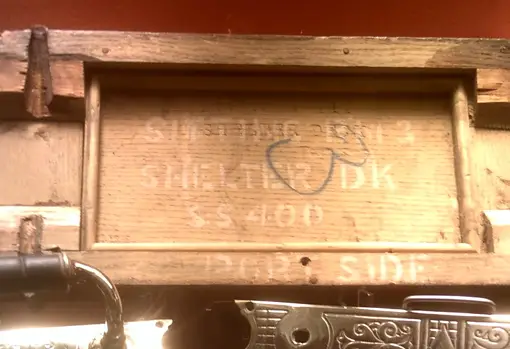
The rear of a wooden panel from the Olympic's portside shelter deck, on display at White Star Memories, clearly shows "SS400" (image courtesy C Marshall).
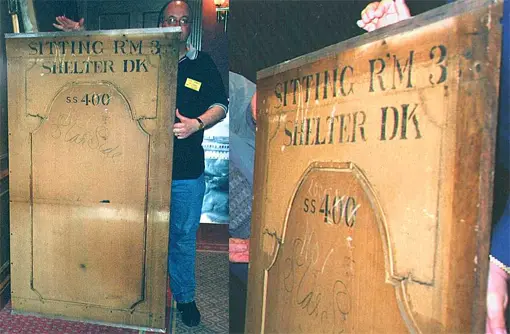
"Sitting Room No. 3," C-62: Louis XIV Room, First Class stateroom, Henry Aldridge and Son auction, year 2000 (image courtesy of rmsolympic.org)
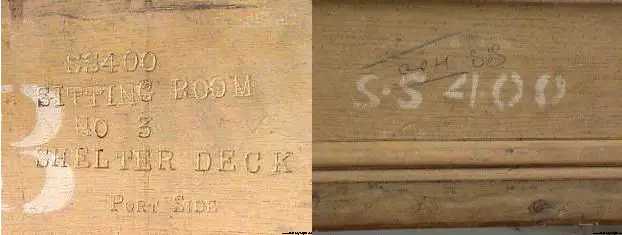
Notice how the number is in fact stamped into the wood in this image, "Sitting Room No. 3," C-62: Louis XIV Room, First Class stateroom, Henry Aldridge and Son auction, year 2000 (image courtesy of rmsolympic.org)
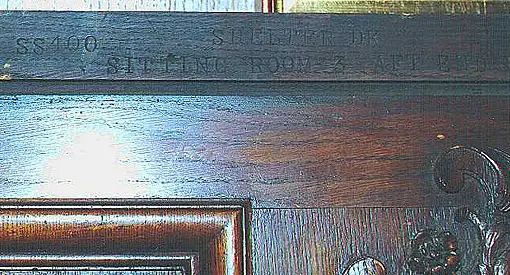
Similarly, notice how the number is in fact stamped into the wood in this image, "Sitting Room No. 3," C-62: Louis XIV Room, First Class stateroom, Henry Aldridge and Son auction, year 2000 (image courtesy of rmsolympic.org)
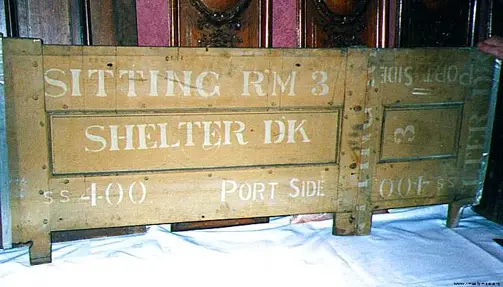
"Sitting Room No. 3," C-62: Louis XIV Room, First Class stateroom, Henry Aldridge and Son auction, year 2000 (image courtesy of rmsolympic.org)
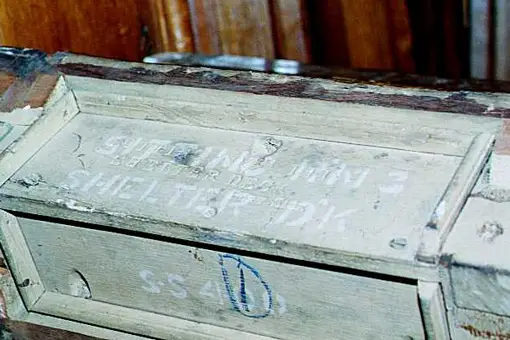
"Sitting Room No. 3," C-62: Louis XIV Room, First Class stateroom, Henry Aldridge and Son auction, year 2000 (image courtesy of rmsolympic.org)
These are just a sample of what I could find; there is no doubt more Olympic aftefacts that testify to being bonafide Olympic with the number 400 on it. Pleae note that the last 5 images are in fact from one single first class room. So just imagine how many numbers would have to be changed for the entire ship! And interestingly, after Titanic sank, panelling found in the sea was identified by her Harland & Wolff yard number, 401
'Switch' theorists would have us believe that every single component bearing these numbers (most of which are hidden) was switched. However this is highly improbable as Mark Chirsnide points out it "took seven months to complete Olympic’s interiors after she was launched. After September 20th 1911, there was no seven-month period in which both ships were out of service and in the same place."
16. Ballard and all subsequent explorers would have to be silenced
Dr. Robert D. Ballard discovered the wreck of the Titanic in September 1985, located about 370 miles (600 km) south-southeast of the coast of Newfoundland, lying at a depth of about 12,500 feet (3,800m) Since then he and many others have dived the wreck, including expeditions from France and Russia. In addition to the hundreds of dives exploring every conceivable angle of the wreck, thousands of objects have been recovered, restored and exhibited around the world.
Neither Ballard, the French, the Russians or any other expedition or explorer has uncovered evidence that the wreck is the Olympic. In fact they have discovered evidence (see below) that proves without doubt that it is Titanic. There is no reason to believe that Dr. Ballard has anything to gain by covering up a then 75 year old mystery. It is no surpirse then, that whenever asked about the switch theory Ballard dismisses it as a question unworthy of consideration.
VWhen questioned about the 'switch' theory at the Belfast Titanic museum Q&A in 2014, the man who discovered the wreck of the Titanic, Dr Robert Ballard, answers: "I think it is the Titanic at the bottom of the ocean."
17. The wreck looks like Titanic
In all aspects the wreck looks like Titanic -there is no evidence of anything that looks like Olympic. Considering that large portions of the superstructure have been revealed due to it being split in two and ravaged over time, you would expect something would show.
For example the wreck clearly has the "Millionaire Suites" on B deck, unique to Titanic. Another good example of how the wreck looks exactly like Titanic is the wheelhouse. Olympic's wheelhouse was curved at the front (refer to diagram below). However on the wreck, the base of the wheelhouse is clearly square with a straight front to it.
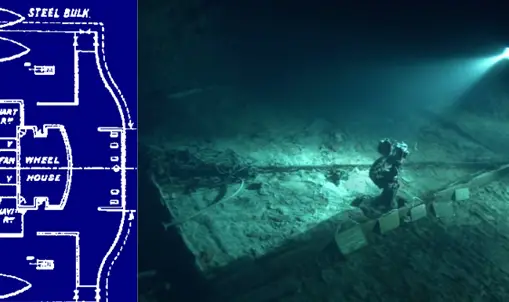
Olympic's wheelhouse in 1912 was curved at the front (left diagram) while Titanic's was straight. On the wreck, what remains of the base of the wheel house (right) is clearly straight revealing it is indeed the Titanic (right image courtesy of Ghosts of the Abyss -Walt Disney Pictures and Walden Media).
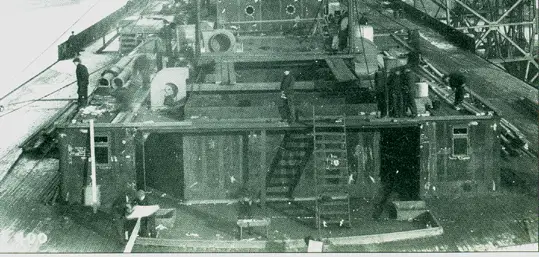
Olympic in the fitting out wharf with construction of the wheelhouse just beginning. The base of the wheelhouse, showing its outline, is clearly curved
(photo courtesy Bob Read/TRMA).
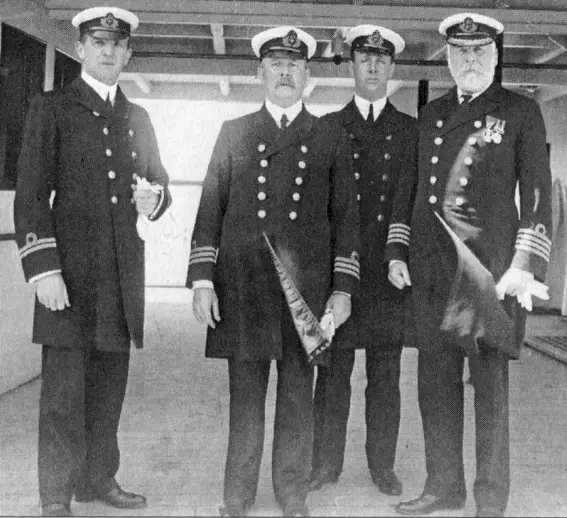
Captain Smith and Olympic's senior officers stand in the bridge area with the curved wheelhouse clearly behind them, left of picture (behind First Officer Murdoch, far left).
18. The wreck has Titanic's number 401
As would be expected, parts bearing Titanic's number 401 have been recovered from the wrecksite: ranging from an engine part; to a marble sink fitting; and other items from all over the ship.
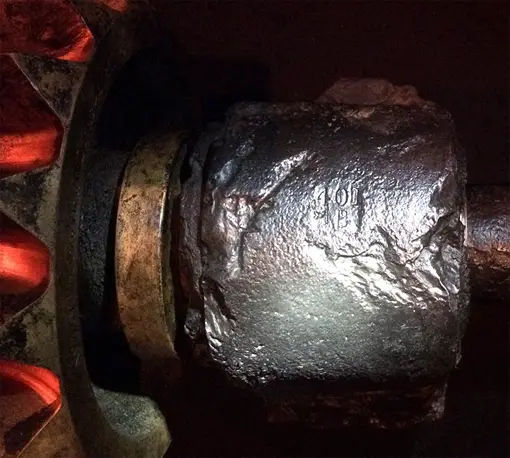
This is a gear shaft recovered from the debri field which originally came from a vertical watertight door either in the bulkhead between Boiler Room #2 and Boiler Room #1, or the forward bulkhead in the Reciprocating Engine Room. Notice how Titanic's number 401 is engraved into solid metal -not something that could easily be 'switched' (courtesy of Parks Stephenson).

The number 401, Titanic's shipyard number, is also on the Titanic's starboard propeller.
19. The wreck has the name Titanic on it
And rather conclusively, the wreck of the Titanic has Titanic's name clearly visible on it. The outline of the letters was incised into the hull plate so they were not painted on or could easily fall off.

Titanic's name on the port side of the bow section of the wreck.
Video footage of Titanic's name, filmed in 1987, clearly visible on the wreck
20. No evidence Titanic was 'switched' with Olympic
Most important of all is the telling fact that there is no evidence at all that Titanic was switched with Olympic. Only theory and speculation. There is no verifiable eyewitness testimony, documentation, photographs, forensic or physical evidence that the 'switch' took place, rather evidence that it definitely did not take place as already listed above. However you might then argue that 'switch' adherents mention such things as different port holes in photographs, a nearby ship waiting near the disaster scene with woolley blankets and Olympic's name being on the wreck. Is this evidence? Take a look on the following page and see the truth about these claims.